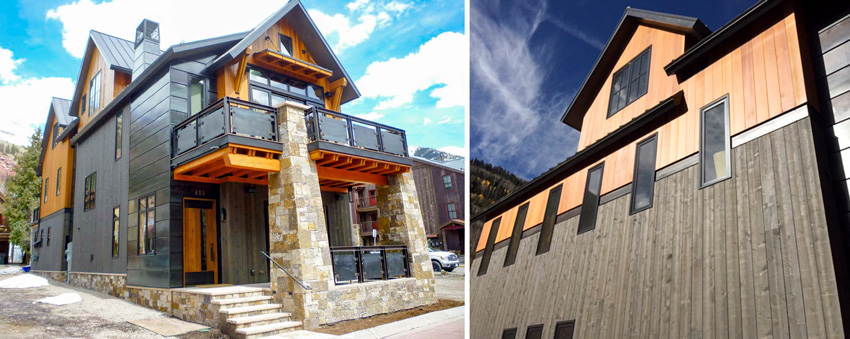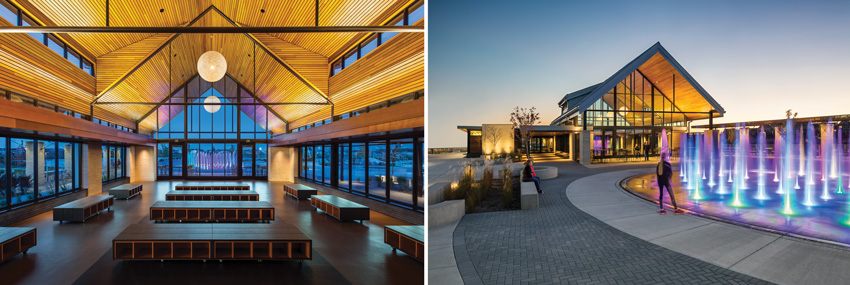Using Western Red Cedar in Commercial and Multifamily Buildings
Telluride Upscale Rustic Resort
About the Project: Building in the resort community of Telluride, Colorado, requires extensive effort on the part of developers to ensure that everything from design to materials meet the standards of regional historical and architectural review committees. A three-story, 3,500-square-foot resort home completed by builder Eric Trommer was no exception. Fortunately for Trommer and his architect Matthew Allen, their decision early on to use WRC extensively in the construction process ensured that the resulting building not only achieved regulatory approval, but its visual appeal also blended perfectly with Telluride’s rustic and distinctly upscale ambiance.

© Matthew Allen
The Design: In order to capitalize on Telluride’s reemergence as a place where affluent people converge, Trommer wanted his $4.5-million development to stand out. With a narrow lot of only 30 feet wide, Architect Allen designed a luxury residential unit of five bedrooms and five bathrooms to be spread throughout three levels. “This was a rethinking of an earlier design that just didn’t work in these narrow confines, and while Eric and I were pleased with the redesign, I still wanted to minimize the feeling of mass and also incorporate some of the best visual elements evident in nearby units,” he says.
The Cedar Solution: The partners were impressed by the clear cedar exterior elements of many homes in the region, and Allen was inspired to go a step further by designing the upper exterior portion of his project to be clad in clear cedar siding and the bottom portion to be clad in black-stained knotty cedar. One popular option for creating a black appearance is called Shou Sugi Ban, which is essentially an artfully crafted charring of the wood. While it has a permanent black finish that also provides some texture, it isn’t suitable for all locations since it can rub off onto anything, or anyone, who comes in contact with it. It is also a treatment that is only available from a limited number of suppliers; otherwise it needs to be done in the field, which can produce less predictable results. The greater availability of stains and the option of factory finishing proved to be a better option for this project.
Allen, who has incorporated cedar into his building designs for the past three decades and loves the material so much that his own home as well as his office is 100 percent clad in the wood, also decided to use WRC for accents, angle braces, soffits under the decks, and window trim. As the design progressed, so too did the specifics of the siding: vertically installed 1-by-10, tongue-and-groove, clear, smooth-faced cedar would comprise the upper portion of the house, while vertically installed 1-by-10, tongue-and-groove, textured, kiln-dried select knotty (appropriately stained) would dominate the bottom portion.
Allen says, “This did several things: it established a beautiful visual contrast, and also lessened the appearance of mass. Additionally, black-stained cedar on the bottom would hide moisture stains caused by the 9-foot snow drifts that typically pile up against buildings in this neck of the woods during winter.”
The Construction: Trommer ordered his cedar through his local supplier who sourced the material through Denver to a British Columbia-based mill to provide the goods. Both the mill and the supplier are a member and a Certified Cedar Distributor respectively of the Western Red Cedar Lumber Association (WRCLA). “The wood, which took 60 days to deliver, was stained in Denver as opposed to stained on-site for superior quality,” Trommer says. “It was a most efficient process overall, and the only mistake we made was ordering too little—so we had to wait another 60 days for a second supply of wood.”
As for installation, Trommer calls working with WRC “downright fun. It was lightweight and easy to cut, no effort at all putting up; we used color fasteners for invisibility and attached the facing into the building.”
The Results: Trommer’s experience with WRC is such that he wants to use the wood again in future projects. As for long-time cedar lover, he says, “I’m passionate about using cedar in all my projects for its dimensional stability, longevity, and the special, beautiful glow it imparts that is unique amongst all woods. The suppliers on this project really came through and helped us create a residence that stands out in Telluride—which is no easy feat.”
Cedar Interiors
Turning from cedar exteriors, let’s take a closer look at the many ways that cedar is used for beautifully designed interiors. We have already noted that as a wood product, WRC can be milled, shaped, and finished in many different profiles with many different design options. All of those features apply to interior uses too, not just exterior treatments. Hence, cedar can be quite versatile in terms of design options, allowing it to be used for interior coverings for walls and ceilings to create striking interiors that exude the warmth and the beauty of the wood. Similarly, it can be used for interior features, trim, and other creative or even artistic applications. The choices of finish are all available for interior uses too, but where it is protected from the elements, its color will not change as it does naturally when exposed to the weather. That means clear finishes and light stains may be all that is needed to bring out the grain and character of the wood for an extended period of time.
Recognizing that there are many interior options, we will take a look at two notable projects with two very different interior design styles. The first is a very contemporary interior for a public park building, and the second is a more traditional look for a museum.
Maple Grove Park Warming House & Pergola
About the Project: When its development was completed in September of 2015, Central Park of Maple Grove, Minnesota, provided Maple Grove’s evolving downtown civic, retail, and residential core with a lush, energized urban green space that builds upon an extensive pedestrian trail system and chain of lakes. Almost immediately, the park generated national media attention as an iconic regional destination with 40 acres of recreational amenities, including a 2.5-acre event lawn, formal gardens, custom playground, and 25,000-square-foot ice skating loop—the first of its kind in Minnesota.

Photos: © Andrea Rugg Photography
Capping all of this is a spectacular pavilion/warming house with concessions as well as an adjacent pergola, the structures of which fulfill the mandate of the city’s Parks and Recreation Board to achieve a lodge aesthetic combined with a more contemporary take on the warming house function. U+B Architecture & Design, architect for the project, used WRC predominantly throughout this project to unite these two disparate aesthetics as well as for its resilient properties in this unique outdoor setting.
The Design: U+B had to fulfill the needs of multiple stakeholders while working on Maple Grove Central Park, including those who wanted traditional looking structures and those seeking a contemporary take. To enhance walkability throughout the park, U+B had to create views that would connect visitors throughout the sprawling site with architectural components designed to address park programming. The overall design essentially creates a community of buildings, each serving a specific function while maintaining its individual identity and yet united by a common palette of materials.
Edie Sebesta, senior associate at U+B, points out that to a degree, the architecture was inspired by the landscape of Maple Grove, which had traditionally been a farming community. Accordingly, the architects’ vision of the park’s structures would manifest itself in features such as steeply pitched roofs and the extensive use of wood. Canopies would play a vital role in connecting buildings to the rest of the site and providing gathering spaces for the public. Early on, it was decided that WRC would be a primary building and finishing material, and this facilitated the choice of complementary materials such as dark masonry and Alabama limestone as well as metal roofing of the type typically used in barns.
The Cedar Solution: U+B’s architects have worked with cedar many times on past projects, and the wood was a logical choice for a public space that would see year-round visitations. Plus, given Minnesota’s harsh winters, Central Park buildings required a key material that would not only endure the elements but also take on an intriguing patina as it aged. Sebesta explains that WRC bridged the gap between tradition and modernism that the stakeholders were seeking. For example, its use as a ceiling material in public spaces imparted the warmth associated with traditionalism and still allowed the architects to create clean, minimalist spaces and forms. Tongue-and-groove cedar as a canopy underlining united these structures and connected the interiors with the exterior.
The primary space of the warming house features an interior cedar ceiling, each panel of which was finished off-site and then installed with a clip system that accommodated felt strips for acoustic control. The cladding also served to conceal the building’s mechanical systems. Additionally, U+B took the opportunity to clad two very large barn doors and a bifold door that open and close the service counters with the same clear cedar. In order to preserve and enhance the warmth of the material, U+B used a semitransparent oil-based stain, factory applied, that brings consistency to the look of the cedar across the range of light to darker cedar while still showcasing the natural beauty of the wood grain. The architects also specified a UV-protective topcoat to ensure the tone would remain consistent and warm, even as the buildings ages.
The Results: WRC was warmly embraced by the architects and all of Central Park’s stakeholders, and it has helped this public amenity become a true destination for Maple Grove residents. Ernie Sebesta, who visits the park regularly, notes that visitors “appreciate the warmth of the material, and it’s almost a subliminal effect, just like a roaring fireplace attracts people in a cold room. WRC was the perfect type of wood for this unique project.”









